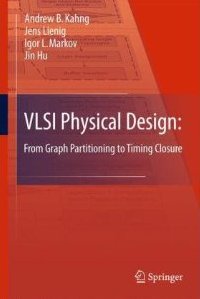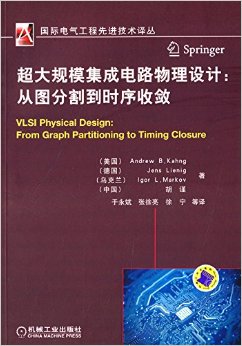VLSI Physical Design: From Graph Partitioning to Timing Closure
VLSI Physical Design: From Graph Partitioning to Timing Closure
Andrew B. Kahng, Jens Lienig, Igor L. Markov, Jin Hu
ISBN 978-90-481-9590-9 (English), ISBN 978-7-111-46297-2 (Chinese)
The design and optimization of integrated circuits are essential to the
production of new semiconductor chips. Modern chip design has become so complex
that it is largely performed by specialized software, which is frequently
updated to reflect improvements in semiconductor technologies and increasing
complexity. A user of this software needs a high-level understanding of the
implemented algorithms. On the other hand, a developer of this software must
have a strong computer-science background, including a keen understanding of
how various algorithms operate and interact, and what their performance
bottlenecks are. This book introduces and compares algorithms used during
physical design to produce a geometric chip layout from an abstract circuit
design. The emphasis is on the essential and fundamental techniques, ranging
from hypergraph partitioning and circuit placement to timing closure.
Editorial Reviews
This book covers the basic algorithms underlying all physical design steps and also shows how they are applied to current instances of the design problems. It will serve the EDA and design community well. It will be a foundational text and reference for the next generation of professionals who will be called on to continue the advancement of our chip design tools.
Dr. Leon Stok, Vice President, Electronic Design Automation, IBM Corp
A clear sign of when a field matures is the availability of a widely accepted textbook. Finally, there is a well-balanced textbook that introduces the key components of a layout synthesis flow with sufficient depth and an eye for the context in which they are used.
It lucidly presents what any maker of chip design tools should have as a core foundation.
Prof. Ralph H.J.M. Otten, Technical University of Eindhoven
This is the book I wish I had when I taught EDA in the past, and the one I'm using from now on.
Dr. Louis K. Scheffer, Howard Hughes Medical Institute
I know of no other work that's as comprehensive and up-to-date, with algorithmic focus and clear pseudocode for the key algorithms.
The book is beautifully designed!
Prof. John P. Hayes, University of Michigan
The entire field of electronic design automation owes the authors a great debt for providing a single coherent source on physical design that is clear and tutorial in nature, while providing details on key state-of-the-art topics such as timing closure.
Prof. Kurt Keutzer, University of California, Berkeley
An excellent balance of the basics and more advanced concepts, presented by top experts in the field.
Prof. Sachin Sapatnekar, University of Minnesota

